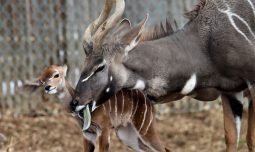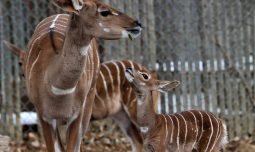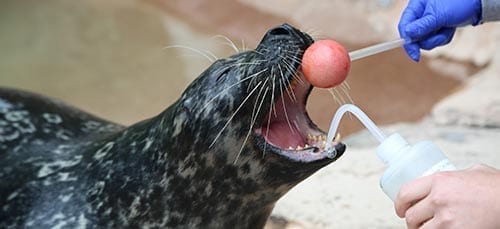Classification
Class Mammalia
Order Artiodactyla
Family Bovidae
Genus Tragelaphus
Species imberbis
Habitat & Range
Kudus live in the arid and semi-arid scrublands found in their African ranges.
Lesser Kudus inhabit a range in northeast Africa and are native to Ethiopia, Kenya, Somalia, South Sudan, Tanzania, and Uganda.

Lesser Kudu
Tragelaphus imberbis
Female lesser kudus will form small groups of twos or threes; males sometimes form small bachelor groups, but are typically solitary. Mature males and females are easy to tell apart. They are sexually dimorphic (sexes have different characteristics) with the males having a grey-brown hide and horns, while females have a reddish-brown hide and no horns.
Adaptations
- Lesser kudus have cryptic coloring (coloring which allows them to blend with their environment) provides excellent camouflage in the scrublands that make up their habitat.
- Kudus enhance the effectiveness of their camouflage by remaining motionless for long periods of time, making them hard to spot.
- These antelopes have large ears and fantastic hearing to help the detect predators.
- Kudus use a warning bark to warn others of the presence of predators when threatened.
Physical Description
- Kudus are spiral-horned antelope where males have horns that twist 2.5 times, form a chevron pattern above their heads, and may reach 3.5 feet (60-105 cm) in length.
- They are sexually dimorphic (sexes have different characteristics) with the males having a grey-brown hide and horns, while females have a reddish-brown hide and no horns.
- Males are also larger than females, standing about 37-41 inches (95-105 cm) at the shoulder and weighing 203-238 pounds (92-108 kg). The smaller females stand about 35-39 inches (90-100 cm) and weigh 123-154 pounds (56-70 kg).
- Both sexes have a white stripe running down the back with 11-14 branches that run down the kudu’s sides.
Diet
What Does It Eat?
In the wild: Kudus feed on the leaves, twigs, grasses, herbs and fruits found in their habitat.
At the zoo: Alfalfa hay, wild herbivore grain, browse (plants) and produce
What Eats It?
Lions, leopards, wild dogs, and spotted hyenas all prey on these antelopes. These antelope are also hunted by humans.
Social Organization
Female lesser kudus will form small groups of twos or threes; males sometimes form small bachelor groups, but are typically solitary. Kudus do not express any territorial behaviors and fights are rare, typically only seen in breeding season. Kudus of both sexes will stand on their hind legs and take part in shoving contests. Kudus browses the scrubland bushes at dawn and dusk, seeking shelter in the dense brush during the daytime.
Life Cycle
With no set breeding season, rutting males test the urine of all females they approach to determine their readiness to breed. Females carry their offspring for 6-8 months before segregating themselves to deliver a single calf weighing 16.5 pounds (4 to 7.5 kg). These calves remain hidden in grasses while their mothers forage for about 4 weeks. After that initial period, they gradually spend more time with their mother until they are weened at around 6 months. Fifty percent of calves do not survive to six months and if they survive, will reach sexual maturity at 15-18 months. Males do not commonly reproduce until 4-5 years when they achieve the required social status to be successful. Kudus have a lifespan in the wild of 10-15 years and may reach 20 years in captivity.
Collection Connection
- Moscato is a female born here at the zoo 9/17/2013. She is shy and can be identified by her orange tag.
- Joe was born 4/20/2015 at another zoo. He is friendly, loves scratch sessions with his keepers. Joe’s tongue hangs out due to an injury at another zoo, but it does not bother him. You may see Joe with browse caught on his head after a sparring session with it.
- Elsa wears a blue tag and was born 4/5/2014. She is a curious and brave kudu, occasionally accepting treats from keepers, but only on her terms
- Winifred was born at the zoo 2/5/2019. She sports a yellow tag and is braver than mom, Moscato. Winifred likes to hang out with Elsa and Eleanor.
- Eleanor was born at Denver Zoo 10/23/2019. Mother Moscato is unable to nurse her so she is being bottle raised. She doesn’t have a tag, and is curious and friendly, but spends most of her time with the herd.
- Lawnald was born at Denver Zoo 1/29/2020. He is curious and brave, but definitely his dad's little man. You can often find him hanging out next to dad, Joe—when he’s not bouncing around his habitat.
Conservation Status
IUCN Status: Near Threatened
Lesser kudus are at risk from agricultural activities, civil unrest, and hunting.

Download the App!
Get the FREE Denver Zoo app today, and be a pro the next time you visit the Zoo. You’ll get access to the Zoo map, daily activities and schedules, animal facts, and more. You can even load your membership card onto the app for additional convenience. It puts everything you need for an amazing Zoo experience right into the palm of your hand!





